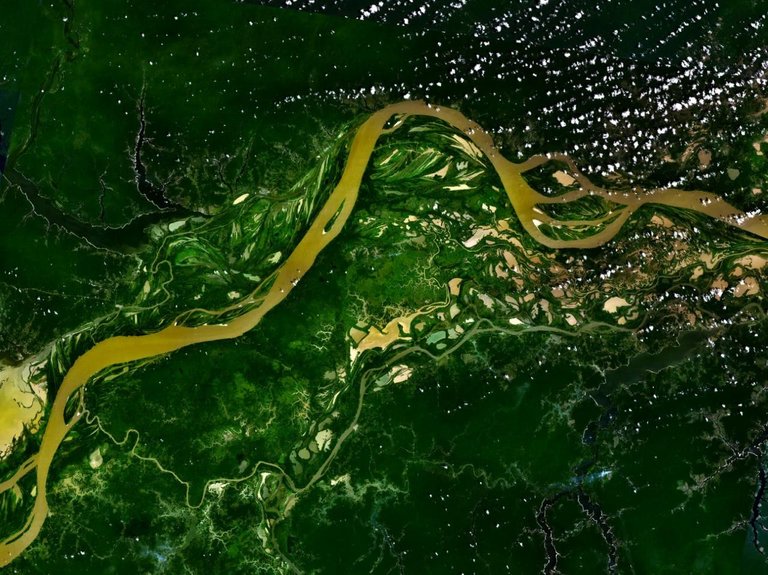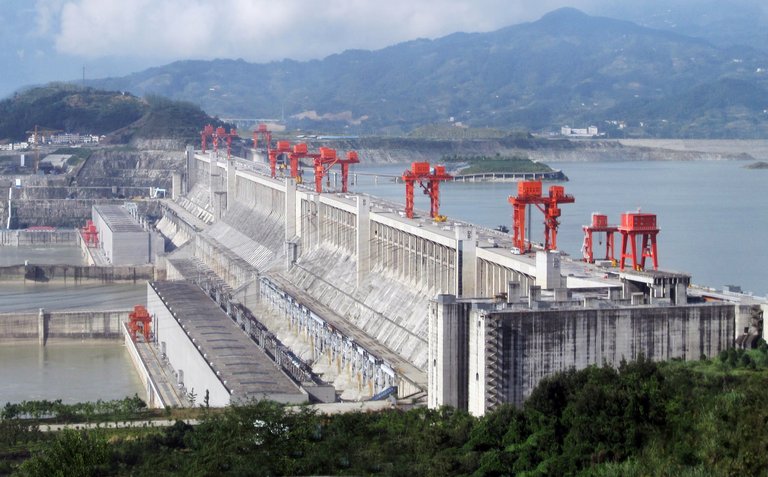The Amazon rainforest is the largest rainforest ecosystem in the world, and it also houses the (arguably) longest river in the entire world. The river discharges more water than any other river, and this makes it a great spot for installing hydroelectric dams to harvest eco-friendly energy from the river.
There are currently plans to build 428 new hydroelectric dams in the Amazon rainforest in the future, while there are another 140 that are already being built or are operational. This means that we are looking at almost 600 hydroelectric dams in the future, which could severely affect the fragile rainforest ecosystem.

A satellite image of the Amazon River. Image by NASA, posted as Public Domain.
What are hydroelectric dams?
Hydroelectric dams are a pretty standard way of harvesting energy from rivers. They create big dams that can hold a large amount of water, where it will be stored until the price for electricity is high, or for when the consumers need it. At that point the dam will open, and the water will fall onto turbines, converting potential energy into electric energy that can be sold to consumers.
This type of energy is considered very ecological friendly, but this is only when looking at greenhouse gas emissions. These dams poses a direct threat to the surrounding biodiversity, and most dams flood huge areas around it, altering the ecosystem. The area below the dam will also be affected by having either very little water, or having a lot at the same time, which will make it difficult for plants and animals to live there.

This is the largest dam in the world, the Three Gorges Dam in China. It has also had very big impacts on the ecosystem in the area! Image by Flickr user Le Grand Portage, posted with the Creative Commons Attribution 2.0 Generic license.
The Amazon is a species hotspot
A species hotspot is where there are very many endemic species is a somewhat small area. The Amazon is one of the biggest hotspots, having thousands of unique species that are not found anywhere else on the planet.
This means that these dams could potentially kill entire species, and once they are gone from the Amazon, they are no where to be found ever again. Luckily most of the dams have some sort of ecological survey before being constructed, but no one knows for sure that these will be made properly, because these can easily be affected by corruption.
The problem with the Amazon hydroelectric dams
A recent paper published in Science goes into detail about exactly this, and their main concern is that even though there are ecological surveys, they are all conducted on an individual basis. Even if none of them have a big impact on the environment or the ecosystem, no one has checked into how big the impact will be once all 400+ dams have been built in the same ecosystem.
They believe that we need to look at these together, and studying the impact on each individual dam is not good enough. And I agree with them! There are so many vulnerable and fragile species in the Amazon rainforest, and we should take good care not to destroy their habitat.
Thanks for reading
About the author
Hi, I’m @valth! I live in Norway with my girlfriend, our newborn son, and our two dogs, one of which is seen wearing a bow tie in the profile picture!
I am very passionate about nature and biology, and have been studying ecology for a few years now. My passions are mostly within conservation biology, mycology (the studies of mushrooms), animal behavior and general microbiology. I really enjoy both the theoretical aspect, as well as the more practical aspect of biology, and I spend about as much time in front of biology textbooks as I do spend on finding and identifying plant, mushroom and animal species in the forests.

That's a lot of dams. It will be a mess. It's more or less easy to predict and simulate the effect of one or few dams but the cumulative effects of that many dams are almost impossible to foresee. Too much intertwined variables and many resources and processes to consider (water, soils, nutrient cycles, flora, fauna...)
Yeah, it is impossible to foresee how much damage they will do together, but the biggest problem is that no one is even tasked to attempt it!
Dams disrupt the subtle atmospheric flows, thus harming the weather organism, as well as the direct terrestrial damage from the flooding.
Greetings to your lovely family @valth, your post is amazing, it saddens my heart to see that man is always carried away by instant gratifications over gain without proper analysis on the long term effects over the action, This is a global issues that concerns all, we must give the coming generation a better ecosystem, we shouldn't make gains now and left the future generations with an unbearable world. Please keep your good work and your passion going.
I'll hook up with you for your next post, meanwhile I've up voted this. LOVE from @maxdevalue.
Thanks, I'm glad you liked my post :)
I agree with your points, I think we really should be a lot more concerned about the environments and ecosystems we are destroying for short-term profits.
They should stay away from one of the few rainforests left that's what!
Yep, that would be the best :)
This is good content valth, i like your blog! ✔
Thank you, I'm glad you like it!
click here!This post received a 19% upvote from @randowhale thanks to @valth! For more information,
fellow nature lover doing my first foray into steem to share my travel and nature photos here. I really like the conservation theme in your posts! It's refreshing to see someone who's done the work to pull together really informative pieces and who's attempting to spread a bit of useful good here. (I'm not saying I'm discovering a lot of shitposting as I'm starting to explore... but...)
Thanks for the nice feedback!
This is like burning your own house to get some heat during winters this is not a wise decision.
Haha, I like that comparison ;)
Thanx dear